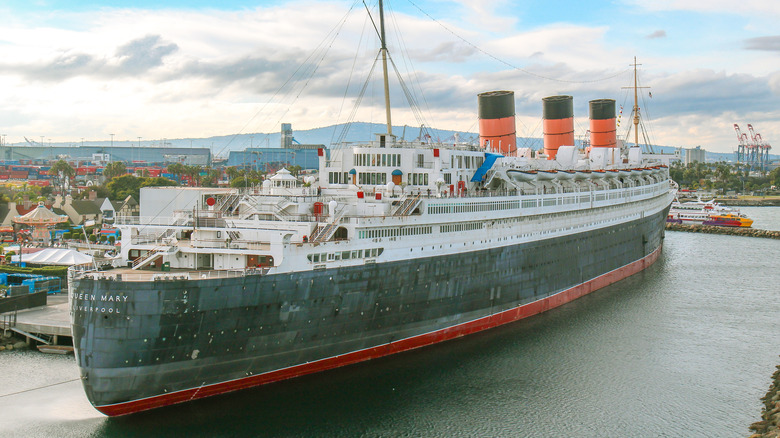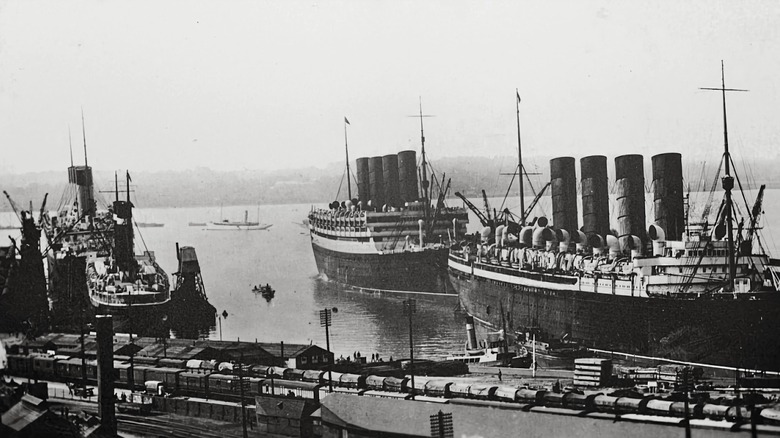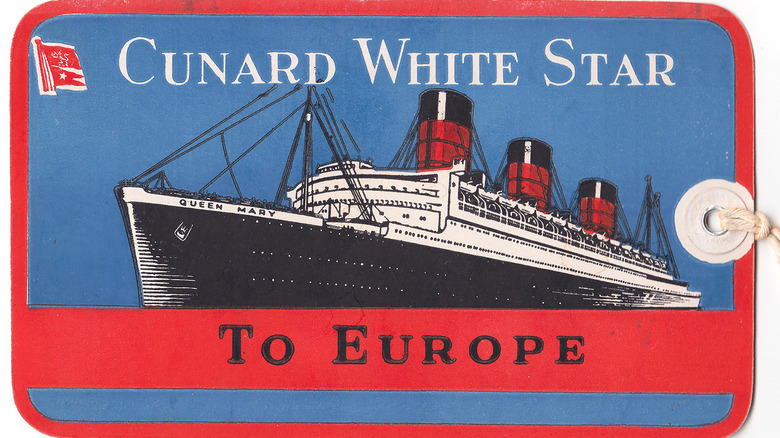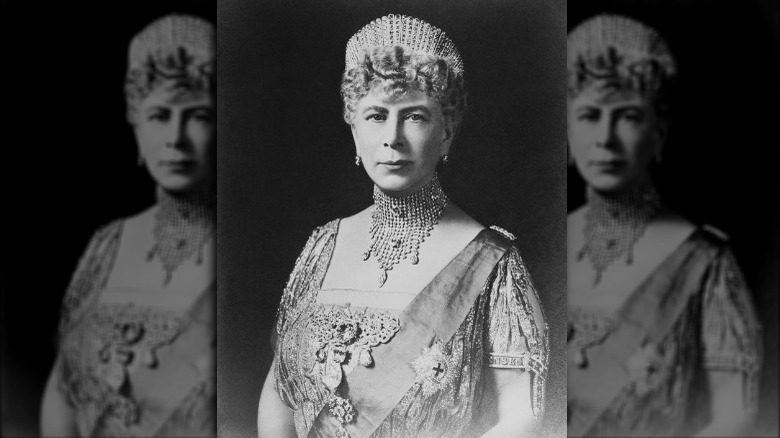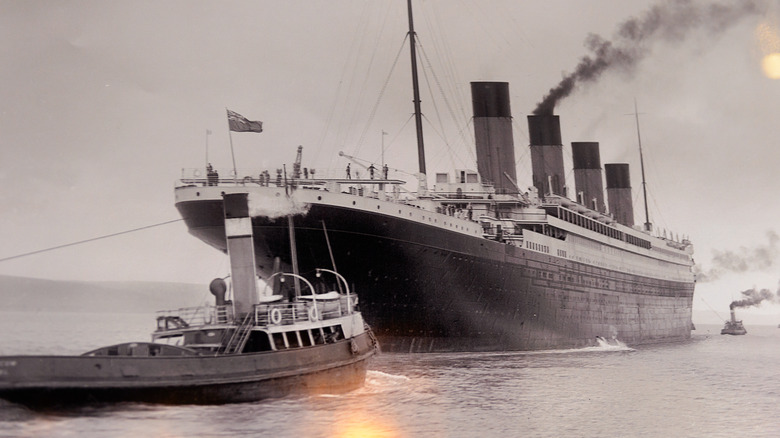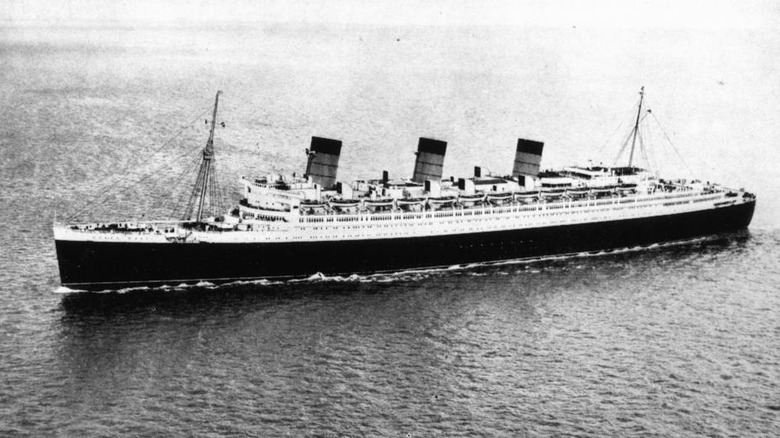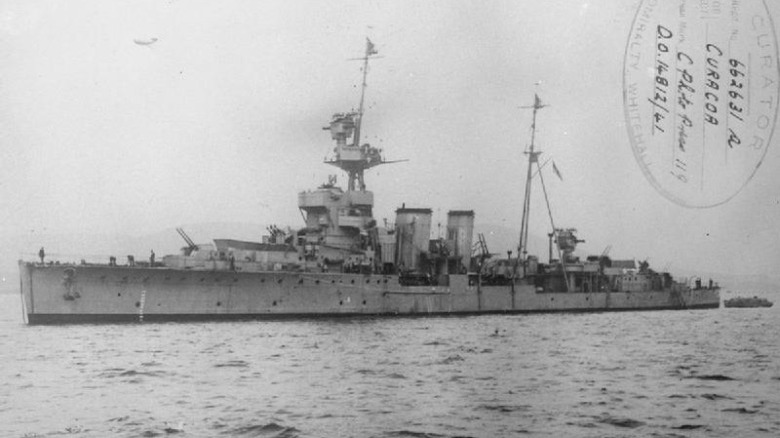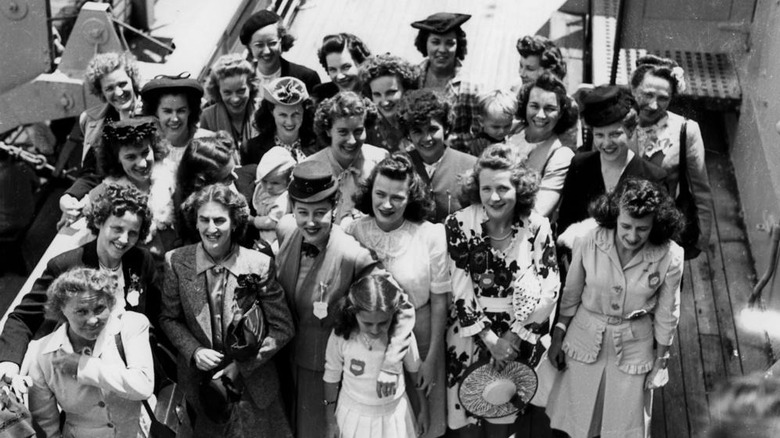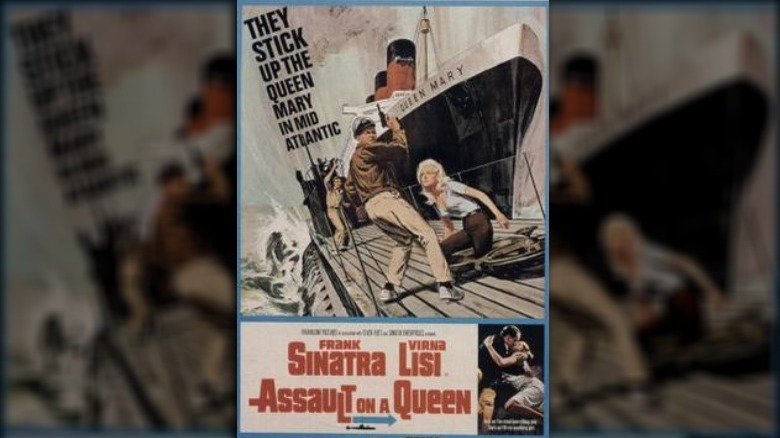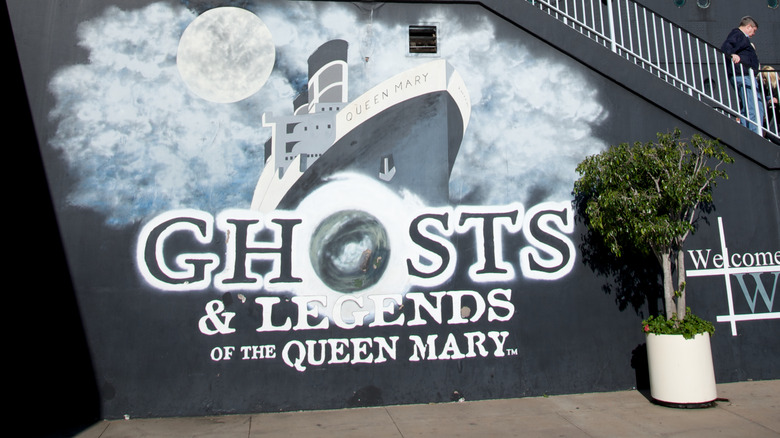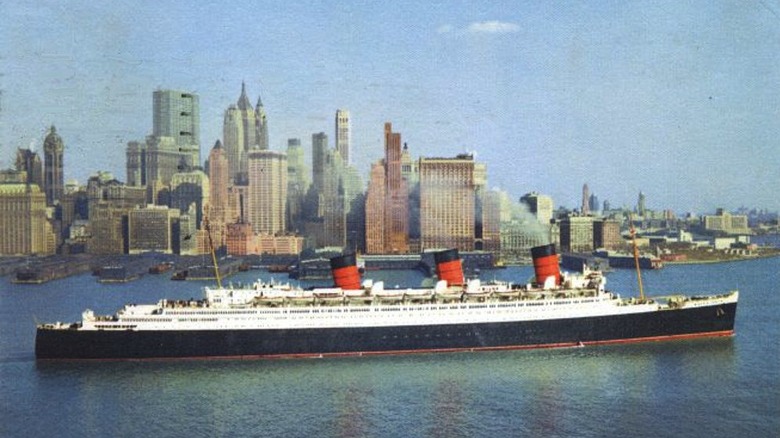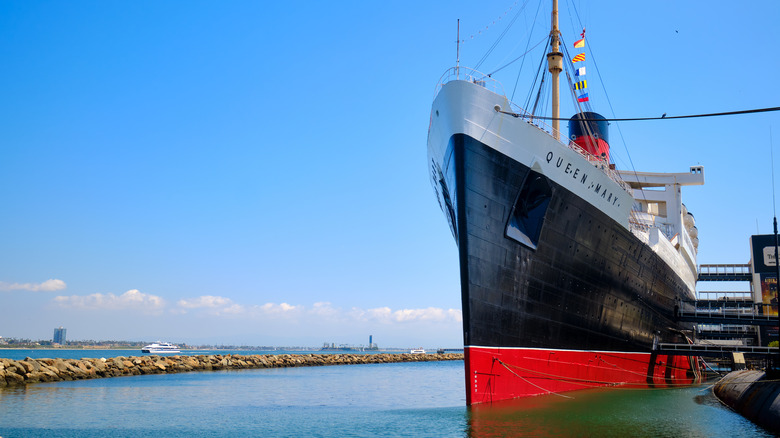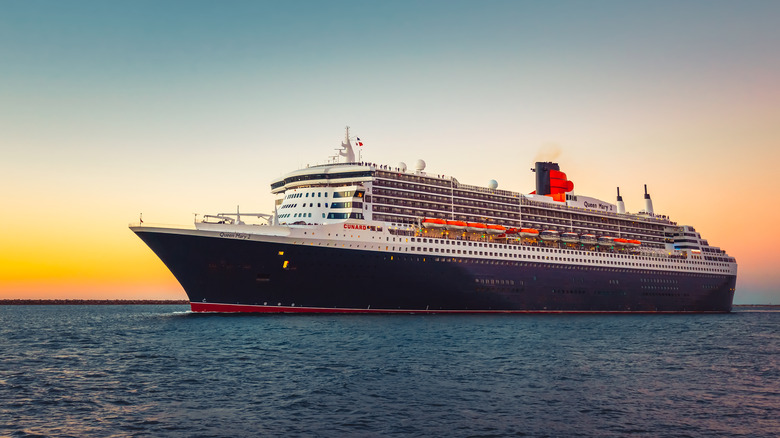The Untold Truth Of The RMS Queen Mary
With its Titanicesque looks, its colorful history, and at least 600 different ghosts roaming around its decks, the Queen Mary is a floating link to a time period inhabited only by Kate Winslet and Leonardo DiCaprio, who by the way could both have totally fit on that door. Actually, the Queen Mary postdates the Titanic by about 20 years, but like the Titanic, it does seem to be sinking. Sort of. The LA Times says the hull is leaking and no one seems willing to foot the $289 million bill to make the ship seaworthy again. If something isn't done soon, the Queen Mary could be on the bottom of the harbor in as little as two years.
It's not super clear what it would take to fix the leaking steel hull of a ship that's been sitting in seawater for more than half a century, although $289 million is enough to buy 9,639,760 cans of Flex Seal at Home Depot, which seems like a pretty straightforward approach. But if no one steps in to save the old liner, it would be a rather colorful end for a ship that's led a pretty colorful life. So in case you haven't already heard the story of Titanic's younger, more attractive sister, well, here it is.
The ship was born out of an epic struggle for domination ... sort of
During the early 20th century, two shipping companies were locked in an eternal struggle for the coveted title of "greatest shipping line of all time," kind of like Dormammu and Doctor Strange only with less smolder. According to MollyBrown.org, Cunard was the dominant shipping line until famous rich guy J.P. Morgan bought the White Star Line in 1902 and suddenly Cunard was at risk of being outspent. Cunard countered by making a £2.6 million deal with the British government, which allowed them to build two new ships and set new transatlantic speed records. But White Star Line had a parry — it decided to build a ship that maybe wasn't super fast but was bigger and more luxurious than any Cunard ship, and also unsinkable. We all know how that turned out.
Anyway, you would think the sinking of the Titanic would have humbled everyone enough that they would stop with all the petty competition, but no. By the 1920s, Cunard's flagship the Mauretania was starting to show its age, and the line needed a replacement. Instead of just building, you know, a replacement, it designed the largest passenger ship of all time and then decided to build two of them. But things didn't really go as planned.
Cunard and White Star, K-I-S-S-I-N-G
You know how life always happens while you're making other plans? Well life totally happened to Cunard when it was about two-thirds of the way finished with its new unnecessarily ginormous ship. According to one maritime historian, Cunard halted construction on December 11, 1931, less than six months before the ship was due to be launched. The reason: the Great Depression was in full swing and no one was traveling overseas or even sending their stuff across the ocean anymore. Cunard's profits were way down, and it couldn't justify sinking (har-har) any more money into a ship that might not leave port for years.
Cunard's decision had major consequences, especially for its huge workforce, who all lost their jobs as construction was suspended. Meanwhile, the White Star Line was hurting, too, even though people in general were mostly over the whole "unsinkable ship" thing. Both companies turned to the British government for assistance, and the British government was all, "Hmm this is totally like Romeo and Juliet, they should get married." So it agreed to provide a £9.5 million loan for the completion of the Queen Mary (then called just "Hull 534"), but only if the White Star Line merged with Cunard. And the two companies looked at each other and went "ew," but they did do it, because they really didn't have a whole lot of other options.
The ship was named for England's greatest queen ... well, almost
Cunard wanted a remarkable name for its remarkable ship, but it was kind of limited by its own traditions. Cunard ships were always named something-ia, like Lusitania, Mauretania, enterobacteria, and hypoglycemia. Fortunately, those last two never made it past the Cunard naming committee (that was a joke, those two names were never contenders). Anyway, according to legend (and the Queen Mary's official website is pretty explicit about making sure you understand this is a legend), Cunard's board of directors decided to name the ship the Queen Victoria, but before they could officially do that they had to first run the idea by the current king of England, George V, who was the grandson of Queen Victoria and was married to Queen Mary.
According to the story, the directors approached the king with the words, "We have decided to name our new ship after England's greatest queen." And the king replied, "My wife will be delighted that you are naming the ship after her." And then the Cunard directors probably smiled politely and pretended that's what they had in mind the whole time, and when they left the room the one who said that thing about "England's greatest queen" got clocked on the side of the head for being a nitwit and then Cunard broke their own naming convention and called the ship the Queen Mary because really, what else they could do?
The Queen Mary was bigger than the Titanic
Looking at the Queen Mary, you can't help but make comparisons to that famously unsinkable ship, that bastion of human arrogance, that whole "I'm the king of the world thing" people still get in trouble for doing on cruise ships. The Queen Mary does look an awful lot like the Titanic, but there are some important differences. First, the Queen Mary isn't sitting on the bottom of the Atlantic. Second, the Queen Mary has only three funnels; Titanic had four. Though to be fair, Titanic's fourth funnel was totally fake — it was only there for ventilation and basically just to make the ship look cooler than all those pathetic three-funneled ships.
That's where Titanic's advantages end. According to QueenMary.com, Titanic was just under 883 feet in length, but the Queen Mary is nearly 1,020 feet. In gross tonnage it's nearly twice the size of Titanic: 81,237 compared to 46,328. In its glory days, the Queen Mary had almost three and a half times as much horsepower as Titanic, and it was faster by a third. Also, and perhaps most importantly, it had more lifeboats. All its lifeboats together could save around 3,000 people, and add up all the other rafts and floats that were on board and roughly 8,000 people could survive a sinking, which is great because having that many people on board might have actually rendered the ship not very seaworthy.
The Queen Mary was also pretty fast
Much of the petty competition in shipping had to do with a dumb unofficial award. The "Blue Riband" was the most coveted prize on the high seas — only one ship could claim it: the ship that held the record for the fastest transatlantic crossing.
For a while, the competition for the Blue Riband was between nations, with Italy snatching it away from England and France snatching it away from Italy and Britain fuming in the corner because it hadn't been the fastest since 1909. According to Maiden Voyage, the Queen Mary represented the first real opportunity Britain had to claim the accolade in a long while.
When the Queen Mary set off on its maiden voyage in 1936 France held the title, but bad weather prevented the Queen Mary from immediately wiping the smug little grin off France's face. Within a few months, though, the ship had proven you don't have to be lean and mean to be a speed machine. On March 9, Queen Mary became the first ship to cross the Atlantic in less than four days. France did manage to reclaim the title the following year, but it would be a while before they got to fart in Britain's general direction again. Queen Mary recaptured the Blue Riband in 1938, making the transatlantic crossing in 3 days, 21 hours, and 38 minutes. No ship was able to beat that for another 14 years.
Then the Queen Mary killed some people
The Queen Mary may seem like a fairy tale ship with the luxury and speed records and all, but it was actually kind of a brute. It was huge and not especially agile and when you saw it coming you had to get out of its way because it was not likely to get out of yours.
Never was this more apparent than on October 2, 1942, during the time when the Queen Mary was serving as the SS Queen Mary, transporting thousands of World War II soldiers across the Atlantic. According to World War II Today, the Queen Mary was on a zig-zag course — something ships often did in those days to avoid attack by U boats — when it encountered the light cruiser ship HMS Curacoa. It was almost immediately obvious the two ships were on a collision course, but incredibly, neither captain did anything about it, you know, kind of like when you're 12 years old and talking to your boy/girlfriend on the phone and you're both like, "You hang up!" "No, you hang up!" "No, you!" and then one of you just gets cut in half and sent to the bottom of the sea.
Anyway, that's exactly what happened to the HMS Curacoa. The Queen Mary was so huge compared to the Curacoa that when the two ships collided, the Curacoa took the brunt of the damage and sank in about six minutes, killing 338 men.
At the end of the war, the Queen Mary became a bride ferry
As it turns out, when you send a bunch of dudes overseas and station them for months in foreign countries, they tend to, you know, find ladies. Sometimes they even get married. Sometimes they start families. Which is actually kind of problematic when there are immigration quotas back home, and your bride isn't on the list of "acceptable" new Americans. Fortunately, as World War II was winding down, the United States government recognized they were going to have a lot of unhappy returning servicemen if they didn't change the rules to allow war brides to move to America with their new husbands.
According to the national World War II Museum, the US officially passed the War Brides Act in late December 1945, which exempted war brides from earlier quota systems. Which was cool, but that also meant they were going to have to figure out how to get 60,000 women, many of them with children, to the United States within a fairly short period of time. One way to do that was on troop transport ships like the Queen Mary.
Legends of America says the Queen Mary made 13 "Bride and Baby Voyages" carrying more than 20,000 women and children in 1946, so that was a decent way to maybe sort of make up for the whole cutting-a-friendly-ship-in-two thing it did earlier in the war.
The Queen Mary is a popular movie set
After the war, the Queen Mary went back to its usual steaming back-and-forth across the Atlantic drill. In 1952, it lost the Blue Riband to the American ship SS United States, so its glory days were kind of behind it. Still, the ship continued to captivate people, and in 1966 it served as the set for the Frank Sinatra movie "Assault on a Queen." Granted, "Assault on a Queen" wasn't a great movie, in fact IMDb gives it a 5.6, so it's not like the film was the Queen Mary's big comeback role or anything.
But after that, the ship did end up becoming a pretty popular place to shoot movies and TV shows; titles include "The Poseidon Adventure," "The Aviator," and "Pearl Harbor." According to the Hilo, the ship's most recent foray into Hollywood is a three-part series of horror movies that began shooting in the spring of 2021. The first film is just called "The Queen Mary," and should come out in 2022. There aren't a whole lot of details about the plots of the films, but each one will cover a different period of time in the Queen Mary's history, and based on the fact that they're being described as horror movies, probably lots of people will die in terrible ways. That is, if the ship doesn't sink between now and the time they finally wrap up shooting.
And also, 600+ ghosts
Now let's get to the fun stuff. The Queen Mary is one of the 10 most haunted places in America, and that's not just something Zak Bagans from "Ghost Adventures" said either, because Zak is pretty sure every place he visits is one of the 10 most haunted places in America. That's direct from the Queen Mary's official website, quoting Time Magazine. In fact, Queen Mary's official website has its own "Haunted Encounters" page, where it talks in detail about some of the specific ghosts that roam the ship. Of course, that whole page mostly exists to sell expensive tickets to the Queen Mary's ghost tour, which is lucrative enough that operators probably aren't going to start denying the existence of ghosts anytime soon.
Queen Mary's reputation as a ghost ship and its current role as a hotel attracts a lot of ghost hunters and curiosity seekers, probably more than it repels sensible people who are like, "ghosts, no thank you." And if you're especially into not-sleeping when you're on vacation, Travel and Leisure says you can rent the most haunted room on the ship, stateroom B340, you know, if you dare. Or can afford it.
Some of the Queen Mary's most famous ghosts include various children and other people in period costumes, an engineer who died on the job, and an unidentified lady in white, because just about every haunted location has to have an unidentified lady in white.
Door 13 is one of the ship's most notorious features
Hotels don't have 13th floors and airplanes don't have 13th rows but for some stupid reason, the Queen Mary has a 13th door. And it's a door that really matters, too — one of the watertight doors that are supposed to help keep the ship afloat in the event of a torpedo or an iceberg or sitting in saltwater for 50+ years. Anyway, the ship's builders decided not to let silly superstition get the better of them so they just labeled the doors sequentially and behold, they totally should not have done that.
According to Queen Mary Shadows, in 1942 an unpopular crewman named John McKenzie was crushed to death by Door #13. In case you're wondering, the fact that he was unpopular is totally relevant to the story because he was rumored to have been held there by his fellow crewmen as the door shut. Ouch. That story may or may not be true, but the one from 1967 is definitely true — an 18-year-old crewman named John Pedder also lost his life under Door #13. But because people like to embellish stories or just make them up, we don't actually know if he died trying to duck through the door while it was closing or if he was playing chicken with other crew members. Either way, it wasn't the smartest thing to do around a heavy watertight door, especially one with such an ominous number.
Sometimes people still die on the Queen Mary
If there are really 600 ghosts onboard the Queen Mary, then that means 600 people must have died there. We can only really account for like 49 deaths, though, so maybe the other 551 just hang around because the Queen Mary is cool and creepy and a pretty decent place to haunt, you know, if haunting is your thing. Although if all 338 people who died on the Curacoa decided to jump ship to the Queen Mary, that could certainly account for more than half the 600.
According to LA Weekly, the most recent death was a 26-year-old woman named Kelly Ryann Dorrell, who fell 75 feet to her death into the water. Don't jump to the conclusion that this means the Queen Mary's decks are dangerous, though. In order for this accident to happen, Dorrell had to climb a four-foot rail. Witnesses say she'd been arguing with her boyfriend, who tried to pull her to safety just before her fatal plunge. Her boyfriend and a ship employee both went in the water after her, but it was December and the freezing cold temperatures prevented them from doing much good and they had to be rescued themselves. Tragically, it was too late to save Dorrell.
Book a trip on the Queen Mary's not-haunted and not-sinking successor
The Queen Mary retired in 1967, after a final cruise from Southampton to Long Beach California. Today it's sitting in the water at the Port of Long Beach, where it's been moored for more than 50 years, serving as a hotel, a wedding venue, and a bucket list item for people who think ghosts are fun. Meanwhile, Cunard (which is actually still a thing) launched the new and improved Queen Mary in 2004, which they cleverly named Queen Mary 2 because they couldn't be bothered to come up with anything more original than that. According to All Things Cruise, the Queen Mary 2 is 1,132 feet long and has a tonnage of 151,400, compared to Queen Mary the original's 1,020 feet and tonnage of 81,237. So not that much longer but certainly a lot beefier. And probably with fewer ghosts.
